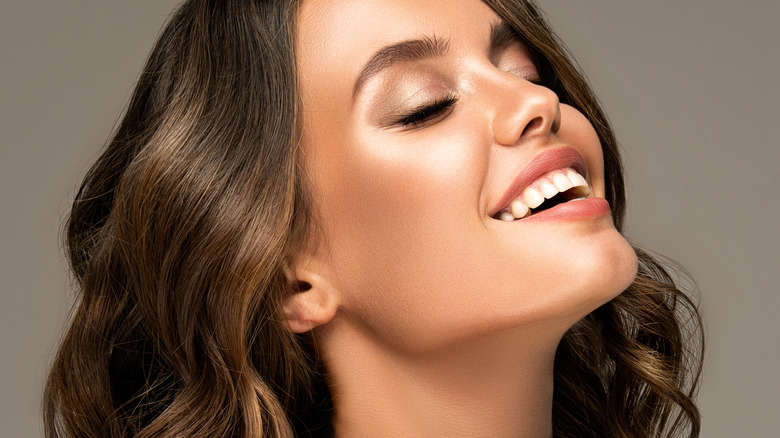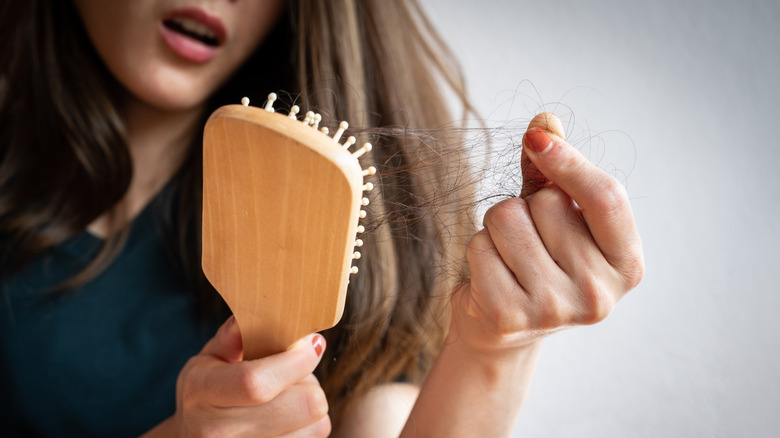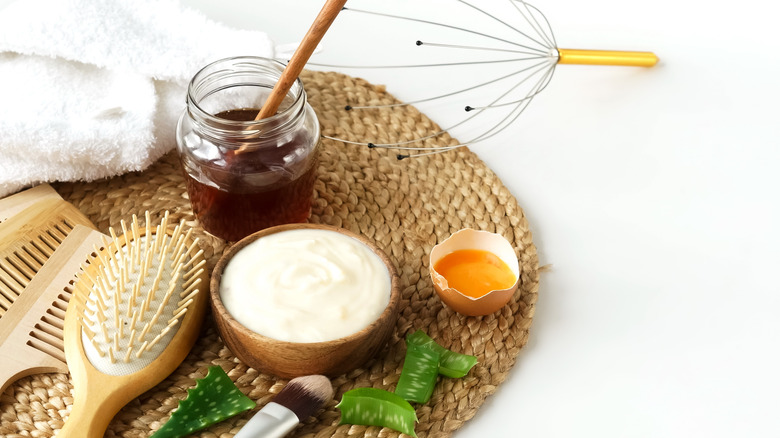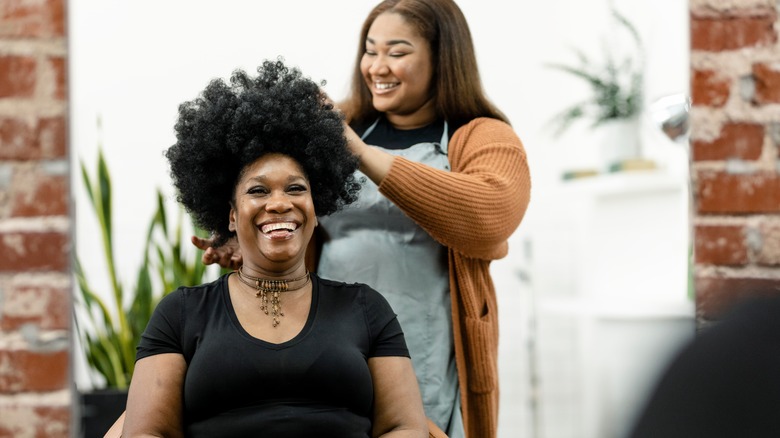The Ultimate Guide To Protein Treatments For Your Hair
We may receive a commission on purchases made from links.
We shampoo, we condition and yet, sometimes the everyday hair care routine is not enough to keep our locks healthy and looking as lovely as we'd like. According to Healthline, we all have protein in our hair, which provides the look of movement and shine that is so desirable. This protein even has a name and you've probably heard it before: keratin, and it's found in the center of every strand of hair on our heads.
Anyone who has stared at their hair in the mirror and noticed dull or even fried-looking locks may be seeing signs of damage due to heat styling regularly and coloring (via Well + Good). Permed or chemically straightened strands are also more likely to appear damaged (via Medical News Today). A diet lacking in proper nutrients can also lead to hair that's less than healthy, with hairstylist Michael Stranko telling Today, "[Lifeless hair] is usually coming from the inside out."
One way to get your hair back on track is to incorporate more protein into meals. And, you may want to try a protein treatment for your hair, which will restore moisture and repair signs of damage. But before you rush out and buy the first one you see on a store shelf, there are plenty of factors to consider, not the least of which is that yes, you can have too much of a good thing when it comes to a protein treatment for those tresses.
How to tell if your hair needs a protein treatment
If your hair is showing signs of protein deficiency — lifelessness, lack of bounce and shine, and overall dullness or is breaking easily — adding a protein treatment to your hair care regimen may help restore some of your former hair glory. Basically, a protein treatment aims to strengthen those strands and who wouldn't want that, damaged or not?
If you aren't sure whether your hair could benefit from a protein treatment, Well + Good recommends evaluating a few strands for porosity and elasticity. Highly-porous hair has microscopic holes in each strand and absorbs water more easily that it should. As salon owner Robin Groover explained to Byrdie, "Hair that is low porosity will float. Hair that is 'normal' porosity will float and then begin to sink slowly. Hair that is high porosity will sink immediately."
Test the porosity of your hair by simply adding a few strands to a glass of water. Once you know where you stand in this department, elasticity is another property of hair that can indicate how healthy it is. You'll just hold one piece of your hair and see if it stretches or breaks right away. Highly-porous and breakable hair is in need of some protein TLC.
What hair protein treatments are exactly
Once you've determined that your tresses are trying to tell you something ("We need protein!"), it's time to act. But first, exactly what is a hair protein treatment?
With those hair tests in mind, think of how Dr. Ava Shamban, a dermatologist, explained the structure of a stand to Byrdie: "As we lose moisture and nourishment, the keratinized protein begins to unravel and break down. It loses strength, elasticity, and the bonds weaken." She added about protein treatments, "Rebuilding, supporting, and boosting this protein matrix is key to healthy hair and scalp. This can be done chemically in the salon or more naturally and botanically at home."
Indeed, the good news about protein treatments is that no matter your budget or other barriers — time, for instance — there is bound to be a solution that can help you address protein breakdown and start to see your hair looking more luxurious and luscious and lovely and, well, you get the picture.
Where to get protein treatments for your hair
Let's start in the hair care aisle of your local grocery store, pharmacy or beauty supply shop — or better yet, on Amazon. It's easy to find a slew of treatments that work to restore the strength of the hair. You can ask a friend what's worked for them or search reviews online to find a product that meets your needs. We found several on Amazon for under $30 for all types of hair, with Allure recommending nearly a dozen products to try for natural hair that's in need of restoration.
Many hair care brands you are already familiar with will offer a protein treatment product, from LÓréal, to Redken. Other than reading reviews and going with a brand you trust, in terms of ingredients, some you want to look for include keratin, biotin, amino acids and silk protein, which all build up bonds in the hair according to Mind Body Green.
Beyond your own bathroom, salons will offer protein treatments as well, so talk to your stylist about options that make sense for your hair texture and needs. Meanwhile, one final option is to create your own protein treatment for your hair using ingredients like yogurt, eggs, honey, avocado, coconut milk and banana (via StyleCraze).
How to use a protein treatment for your hair
If an at-home treatment makes sense for you, note that this new product will be the step between cleansing the hair and conditioning according to Well + Good. Once you have shampooed, apply the protein treatment to your clean coif. It will basically work like a face mask for your mane, but there's an important instruction to follow to avoid doing more harm than good here.
"You do not want to leave protein in your hair longer than what's recommended because you run the risk of 'over-proteinized' hair, which means the hair can become brittle, break, or even fall out," salon owner April Kayganich advises.
Follow your treatment with conditioner. As far as how often to do this step, at a salon it's every month to six weeks but an at-home application can be done once or twice a month (via Martha Stewart).
When is enough enough?
Infusing protein into the hair is healthy but you can also end up overloading your locks with too much of a good thing. As Healthline notes, overuse of protein treatments can be damaging to hair as well, with the keratin or other protein ingredient in a given product building up in the hair and ultimately weighing down your 'do.
Meanwhile, if you have been using protein treatments, oddly, you may notice the opposite effect taking place — and one that is similar to your original hair problem. "Most proteins provide stiffness to hair, especially upon the surface of the hair," Dr. Ali Syed explained to Stylist. "If too much protein is added, the hair becomes somewhat brittle when dry and breaks off." And so, around and around you go!
The best way to avoid overloading your tresses with protein is to follow package instructions if you're using an at-home product. That means using the right amount of the product and not repeating the process too often. And ultimately, if you can't solve your 'do dilemma at home, seek the help of a stylist who can determine next steps.





